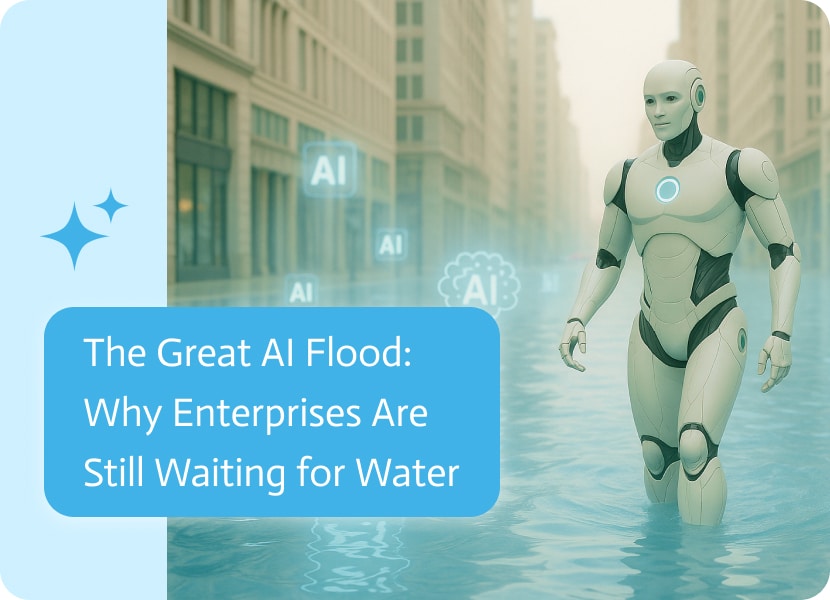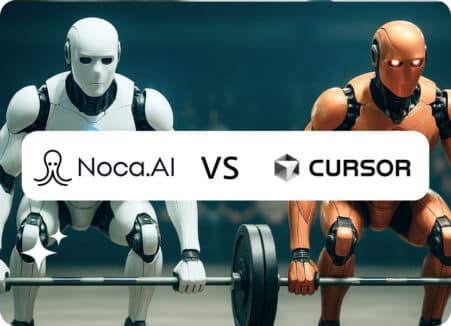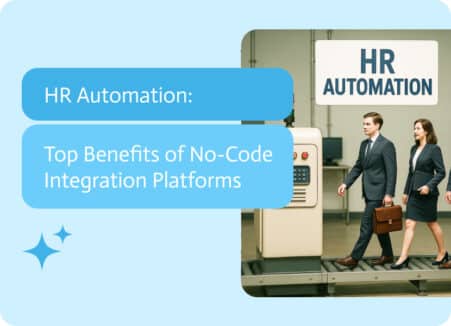

The Great AI Flood: Why Enterprises Are Still Waiting for Water
If you look out the window of your digital life right now, you can see it, a monstrous AI monsoon.
The storm began in the latter part of 2022 and has not abated since. Every day, news feeds are full of new breakthroughs, with each and every one of them promising to be even more pioneering than the last. Venture capital money is flowing like a burst dam, moving from crypto to the new promised land of artificial intelligence at a speed that defies economic gravity. There are so many “thought leadership” remarks on LinkedIn that it’s hard to keep up with all the new “AI experts” who were Web3 gurus just six months ago. Every SaaS product you’ve ever used, from your complicated CRM to the simple app that goes with your toaster, has put a sparkle emoji on its interface and vowed to revolutionize your life.
From the outside, it looks like a flood, and artificial intelligence seems to be soaking the entire world into itself. However, if you look a little more closely at the ground beneath your feet, at the actual soil of the global enterprise ecosystem, it is bone dry.
Despite the raging storm that is present in the media and the startup world, real enterprise AI adoption in production environments is shockingly low. There are thousands of new businesses starting up like mushrooms after this heavy rain, but CIOs, CISOs, and CTOs are slowly coming to the conclusion that this rain isn’t good for them; it might even be radioactive. It is heavy, flashy, and everywhere, but it could be bad for a stable, regulated business.
This technology cycle is all about the difference between the market’s noise and the enterprise backend’s silence. People are splashing around in the puddles while businesses build shelters. This is why the business is making umbrellas instead of reservoirs and why the ground stays dry even though it rains.
The “Cool Factor” vs. The CIO’s Worst Nightmare
To understand why things are stagnant, we must begin to first look at the two forces that are tearing executive teams apart right now: the strong desire to look modern and the terrifying fear of disaster.
FOMO is the bus driver.
“Fear of Missing Out,” or “FOMO,” as the cool kids like to say, is the psychological force behind the current wave, not utility. The fear doesn’t come from the IT department; it comes from the boardroom.
Board members read the Wall Street Journal and see that chipmakers like NVIDIA are growing more and more valuable with each day. Additionally, they see competitors sending out press releases about their “generative AI transformations.” They immediately ask their CEOs and CIOs, “What is our AI strategy?”
This way of doing things makes things more dangerous. This is a big case of the “shiny object” syndrome. Executives feel like they have to talk about artificial intelligence in their quarterly reports to show shareholders that the company is making progress and keep the stock price up. So, a lot of companies are quickly announcing “partnerships” or “pilot projects.”
But if you put a magnifying glass to these announcements, you’ll often find that the strategy is just for general use cases. It is a theoretical pledge to “scout generative potential” as opposed to a real solution that creates value. The urge to look modern is what’s driving the conversation, which is making businesses buy tools they don’t understand to fix problems they haven’t defined.
The “Radioactive” Rain
This brings us to the main metaphor of the present. There are a lot of tools on the market, but this is bad for businesses.
The AI rain is wonderful if you are a hobbyist or a solo business owner. It helps you work faster, increases your creative thinking, and gets more done. That rain is radioactive, though, so if you work for a Fortune 500 bank, in healthcare, or the government, you can’t just open your mouth and drink from it.
Shadow AI is the one of the main sources of this radioactivity. It happens when workers get irritable at how slow corporate IT is and start using consumer-grade AI tools on work devices without any authorization from them. They put private strategy papers into public chatbots to get a summary. They send proprietary code to coding assistants to fix a bug. They use an image generator to turn customer info into a slideshow.
This means they are drinking from a river that is radioactive. They might get hydrated for a short time, but in the long run, they will get sick. This sickness shows up in the business as data leaks, loss of intellectual property, and serious violations of rules.
Although for the untrained eye a start up may look like they’re thriving, just a quick glance behind the facade will show the true impact of drinking the proverbial cool-aid. The moment they try to start scaling, that’s when the cracks appear.
Just like when enterprises gulp the water without contemplating, they will most likely get sued. That’s why the CIO is the “fun police.” They know that every drop that touches the corporate network is a potential liability until it is filtered.
The Illusion of “Prompt-to-App” (and why it fails at scale)
The promise of effortless creation is one of the most appealing things about this new “rain.” There is a huge rise in “Prompt-to-App” platforms, such as Lovable, v0, and numerous low-code AI builders.
The Promise
The sales pitch for these tools is very persuasive, especially for managers who aren’t technical. You can type an English sentence and AI will make a working app.
The demos are almost magical. You type “make me a CRM for a dog walking business with a dark mode and a Stripe integration,” and the interface shows up, the buttons work, the database seems to be connected, and it looks like it’s ready to go. It seems like the ultimate opening up of software engineering, showing the future where anyone who can write can make business software
The Enterprise Realities
But for the enterprise architect, they’re simply just toys right now. They make the outside of an app look good, but they don’t have the important “plumbing” that businesses need.
An app that has been created is like a movie set. It looks like a strong Victorian house from the front. But when you open the front door, you see that there are no stairs, no plumbing, and the whole thing is held up by plywood and hope. They often don’t work when engineers say “Day 2 Operations,” which is the upkeep and integration that happens after the code is written.
Specifically, these “magic” apps usually lack:
- Legacy Integration: Is undoubtedly one of the biggest concerns or caveats. An app that has been rendered sits on an island. It can’t safely talk to a twenty-year-old SAP implementation or a customized Salesforce instance without possibly damaging data or exposing APIs that should stay private.
- Single Sign-On (SSO): They don’t work well with enterprise identity providers like Okta, so you can’t control who logs in.
- RBAC (Role-Based Access Control): Not everyone in a business is an admin. You need to give people very specific permissions so that an intern can’t delete the production database. Apps that are generated don’t often have complicated permission logic built in.
There is also the problem of how easy it is to keep up with. If an AI writes 10,000 lines of React code that no one has read, who will fix it when it breaks? You can’t run a multinational company on “spaghetti code” that no one understands, comes from a model that doesn’t guarantee anything, and is hosted on infrastructure you don’t own. “Prompt-to-App” will stay a novelty, not a strategy, until it fixes the boring plumbing problems.
AI Workers and Agents: Lots of Buzz, No Cooperation
The narrative in the sector has changed quickly. We talked about “copilots,” or assistants who sat next to you, in 2023. Now, all the buzz is about artificial agents in business, or self-driving workers who do the work for you.
The Rise of the “AI Employee”
We are promised a new cohort of workers. Startups are pitching AI Business Development Representatives (BDRs) that can find leads, write emails, and set up meetings while the sales staff sleeps. We hear about AI programmers who can rewrite whole legacy codebases in a single night and AI support agents who can fix complicated tickets without any help from people.
These marketing claims make it sound like these agents are ready to take over for people. They promise a world where physical labor costs nothing. But any CTO who has really tested these agents in a hypothetical playground knows the truth. Right now, most autonomous agents are like excited interns who see things that aren’t there.
They really want to make you happy. They will say with confidence that they have finished a task. But when you look more closely, you see that they imagined a file path, sent an email to the wrong customer, or got stuck in a loop trying to click a button that isn’t there.
The Disconnected Brain
The main reason these agents don’t work in the business world is not because they aren’t smart; it’s because they aren’t connected. They are working in a vacuum.
The quality of an AI agent depends on the data it has access to. Right now, most of these tools are not connected to the “source of truth” for the business. The business data landscape is all over the place; it lives in data lakes (Snowflake, Databricks), ERP systems (SAP, Oracle), CRM systems, and thousands of PDFs on SharePoint.
Most AI agents can’t safely get around in this area. If an AI BDR can’t see your real-time inventory, it’s dangerous because it could sell something you don’t have. If an AI support agent can’t see a client’s ten-year interaction history, it’s just a chatbot with an attitude. It is doing simple, one-off tasks, not complicated business processes.
These agents will stay disconnected brains that can talk but not work until we build the connective tissue, secure APIs, and semantic layers that let an agent “read” the enterprise like a book.
The Great Wall of Fear: Why Adoption Has stalled
If the technology looks good, why don’t companies just go for it? The answer is in how the outcome is different for each side.
Risk > Reward (For Now)
The equation is not balanced for the C-suite right now. AI could make things a lot more efficient, but the security risks of AI are absolutely tangible.
It takes years to build trust and seconds to break it. Take Air Canada, for example. A chatbot made up a refund policy that didn’t exist. The courts said that the airline had to keep its promise to its AI. This scared every corporate general counsel to death.
A bank can’t afford a customer service bot that says it can give you a loan rate that doesn’t exist. A healthcare provider can’t use a diagnostic tool that makes up symptoms. A law firm can’t use a model that uses fake case law.
The biggest thing stopping the model from being used in production is the risk of “hallucinations,” which are confident false statements made by the model. In a creative field, a hallucination is a “spark of imagination.” In a business workflow, a hallucination is a risk. The “Great Wall of Fear” will stay up until the error rate goes down from 1% to 0.00001%.
Loss of Control
Then there’s the “Black Box” issue. In fields with a lot of rules, like finance, insurance, and healthcare, decisions have to be clear.
If a loan officer turns down a mortgage, they need to be able to explain why. For example, the debt-to-income ratio. A federal auditor would not accept “because the neural network weights shifted in layer 42” as a reason for an AI to deny a mortgage.
Because deep learning is like a “black box,” it makes compliance extremely challenging. You usually can’t use AI for significant business logic if you can’t explain to an auditor or a judge why it made a certain choice. The business needs deterministic control, which means that input A must always equal output B. AI is probabilistic, which means that input A could be equal to output B or something like output B. Fear lives in that space.
The Checklist: What “Enterprise Ready” Really Looks Like
So, does this mean the business will never get wet? Will the revolution leave the Fortune 500 behind?
No. The “AI rain” will eventually soak the business, but only after the right infrastructure is in place. We are now moving from the “experimental” stage to the “industrial” stage. To make AI a useful tool instead of just a toy, the “radioactive” parts need to be removed. This is how the filtration system looks:
Data Sovereignty is Non-Negotiable
For big businesses, the time of the “Open AI wrapper,” when they blindly sent private customer data to a public API, is pretty much over. Data sovereignty AI is becoming standard practice.
The model needs to come to the data, not the other way around. This means using open-source models in a Virtual Private Cloud (VPC) or even on your own hardware. It means that there are legally binding promises that user data will never be used to train the base model. The castle walls are going back up, and the data can’t leave the area.
The Boring Stuff Matters Most
Enterprise AI’s future isn’t cool; it’s boring. The companies that will get the enterprise contract won’t be the ones with the coolest demo; they’ll be the ones with the best logs. What “Enterprise Ready” looks like:
- Full Audit Logs: We need to know exactly who asked what, when they asked it, and where that information went. We need to keep track of every token.
- Validation Layers: “Guardrail Models” will become more common. These are smaller models that sit in front of the big LLM and check inputs for Personal Identifiable Information and outputs for toxicity or hallucinations before they ever reach the user.
- Security Protocols: It needs to follow SOC2, ISO, and strict red teaming (hiring hackers to try to break the AI).
Control of the Model
You don’t want a creative writer to handle your accounts payable; instead, you want a strict librarian.
RAG techniques are becoming the norm. With these, the AI can only answer questions based on a set of documents that are given to it, not the module training data. Enterprise AI needs to be dull, predictable, and completely under control. The goal is to turn the LLM’s “wild genius” into a dependable bureaucratic clerk.
Conclusion: Waiting for the Rain to Clean Up
The hype cycle is at its highest point right now, but the utility is behind because there is no safety. The “AI rain” is falling hard, and it’s causing floods in the news and the stock market. The business is still dry, though, because the gutters, filters, containment tanks, and irrigation channels that are needed have not yet been built.
We’re moving from a time of “magic” to a time of “security.” The startups that will make it through the next round of mergers and acquisitions aren’t the ones that promise miracles. They are the ones who sell safety, governance, observability, and integration.
The company will keep its umbrella up until the market stops selling “radioactive” rain and starts selling bottled, filtered, and certified water. But what happens after those filters are made? That’s when the floodgates will really open, and the business’s dry ground will finally bloom.
Author:
Gian Pierre Golden, Senior Content Writer having joined Noca AI in 2025. When he’s not diving into the nuances of AI, he’s diving into the Atlantic Ocean on the idyllic shores of Cape Town, South Africa


